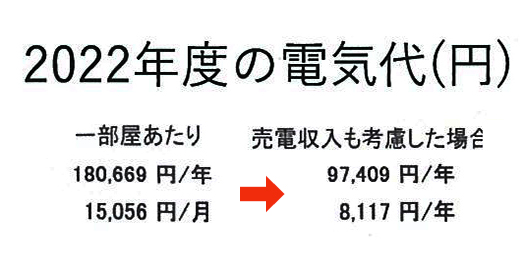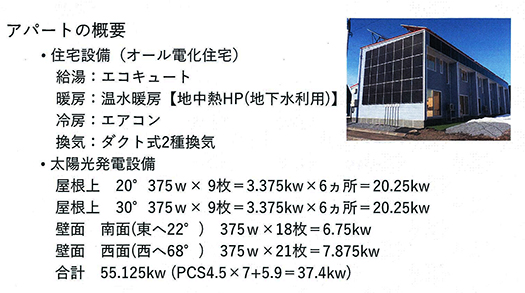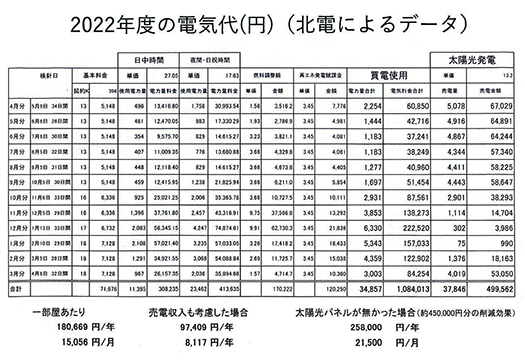

昨日取り上げたZEH達成の北海道深川市のアパートメントの続篇です。きのうは太陽光発電の効率についての北海道地域での挑戦事例という側面を取り上げました。事実、新住協例会での森栄建設の森下社長の発表およびその資料からはそういった側面が強調されていました。
ただ、わたしとしては発表者の発言の中にあった一節が気に掛かっていた。
「こちらは賃貸住宅であり、新築計画段階ではそこそこ反応があって予約的には満室状態だった。しかし、新築が完成してその家賃を発表して入居契約を募ったところ、全部キャンセルになった」
「確かに各戸25坪ほどの賃貸住宅で月98,000円と見かけ上は高いと思われるかもしれません。しかし家賃の中には電気代・冷暖房費・除雪代・駐車場(車庫1台分+平置き1台の計2台分)・Wi-Fi使用料がコミコミで含まれています。これ以外にかかる生活光熱費は水道代のみです。」
というようにアナウンスをして再度募集したら、すぐに満室になったというのです。
ユーザー反応という部分ではこのような部分にホンネがハッキリと表現されていると思います。
新住協という住宅建築の技術研究団体での発表ということで、この部分はほんのさわりしか触れられていなかったのですが、ユーザーと住環境として考えればこっちの方がはるかに有為なポイント。残念ながら、このポイントについてはそれ以上のツッコミはなかった。で、発表後は鎌田先生の講演が続いてあったので掘り下げ取材はできていませんでした。
あらためて森栄建設さんのHPなどをチェックし、このポイントに沿って追加探究。やはり現代生活者の住まいに求めるものがそこには表現されていることが明らかになってきた。

この賃貸住宅はオール電化仕様であり暖房費用は電気代にすべて含まれている。これが大きい。除雪代・駐車場(2台分)・Wi-Fi使用料は北海道ということで必要不可欠な生活インフラ。水道代が各戸別になっているのは深川市の公共料金システム上の制約ということか。ここでのポイントは暖房費と一体の電気代が家賃にコミコミという部分。
こういう賃貸料金の条件であれば、建築全体で可能になった太陽光発電での収支を含めた電気料金を全体計算して各戸に平均で割返すという手法を提示すればユーザー理解を得ることは可能だと思われる。
太陽光発電装置は全戸で共同負担しなければ公平性に欠けることになることと、なにより北海道民として冬期の暖房費用も不可欠なインフラそのものであるという共通認識がある。
わずらわしい生活コストのコントロール、節約の工夫という部分で全戸共有の共通理解が計られやすかったということ。戸建て注文住宅の場合以上に、こういった生活リアリズム・コンパクト志向について共通認識が浸透しやすいのだろう。
太陽光発電についてこのように「公共インフラ費用削減策」と考えて活用する視点は、戸建てではなく賃貸住宅というケースだからこそ、はじめて正視させられた思いがします。
English version⬇
[Compact lifestyle orientation and PV utilization in an era of rising electricity costs
The ability to judge the realism of users’ lifestyles in a remarkable and clear way that is typical of rental housing. The means to fight against the era of exploding electricity bills. The means and utilization techniques to fight against the era of exploding electricity bills.
This is a continuation of yesterday’s coverage of an apartment building in Fukagawa, Hokkaido, which has achieved ZEH. Yesterday, we discussed the challenge of solar power generation efficiency in the Hokkaido region. In fact, the presentation by Mr. Morishita, president of Moriei Construction Company, at the Shinjyukyo meeting and its materials emphasized this aspect.
However, I was concerned about a passage in the presenter’s remarks: “This is rental housing.
The presentation was about a rental house, which was fully occupied with reservations due to the response at the planning stage of the new construction. However, when the new building was completed and the rent was announced, all the contracts were cancelled.
He continued, “Indeed, 98,000 yen per month for a rental house of about 25 tsubo each may seem high at first glance. However, the rent includes electricity, heating and cooling, snow removal, parking (for one garage plus one flat for a total of two cars), and Wi-Fi usage. The only other utility cost is the water bill.”
When the company made an announcement to the public again, the rooms were fully booked right away.
In terms of user response, I think this clearly expresses the true feelings of the users.
This part of the presentation was given only in passing because it was given at the Shinjyukyo, a technical research organization for housing construction, but from the perspective of users and the living environment, this is a much more useful point. Unfortunately, there were no further tidbits on this point. After the presentation, Dr. Kamata’s lecture followed, so we were not able to cover it in depth.
Once again, I checked Moriei Kensetsu’s website, etc., and did additional exploration along this point. It became clear that what modern sei-katsu-sha are looking for in a home is expressed there.
This rental house is all-electric and all heating costs are included in the electric bill. This is significant. Snow removal, parking (for two cars), and Wi-Fi usage fees are essential infrastructure for living in Hokkaido. The water bill is separate for each house, which may be a limitation of Fukagawa City’s utility rate system. The key point here is that the electricity bill, which is combined with the heating bill, is included in the rent.
Under these rental rate conditions, it would be possible to gain the understanding of users by calculating the entire electricity bill, including the income and expenditure from the photovoltaic power generation made possible by the entire building, and then averaging the amount of the electricity bill for each unit.
It would not be fair if all households did not share the cost of solar power generation equipment, and above all, there is a common understanding among Hokkaido-area residents that the cost of winter heating is an indispensable part of the infrastructure itself.
This means that it was easy to achieve a common understanding shared by all households in terms of controlling the troublesome cost of living and saving money. This kind of realism and compactness is probably more easily shared than in the case of custom-built detached houses.
This perspective of using solar power generation as a “public infrastructure cost reduction measure” is something that I think I was able to see for the first time because this was a case of rental housing, not a detached house.
Posted on 7月 8th, 2023 by 三木 奎吾
Filed under: 住宅マーケティング







コメントを投稿
「※誹謗中傷や、悪意のある書き込み、営利目的などのコメントを防ぐために、投稿された全てのコメントは一時的に保留されますのでご了承ください。」
You must be logged in to post a comment.